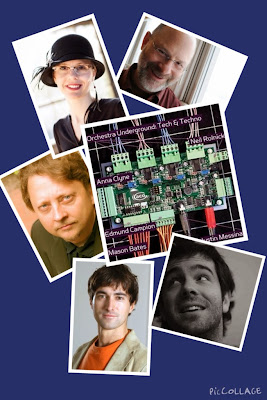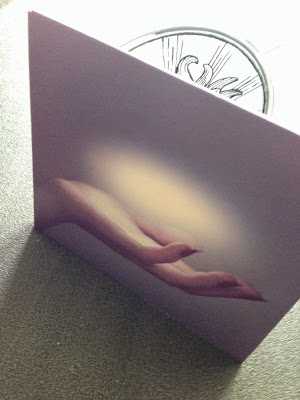When my friend and I entered the performance space, Lorna Dune was already on stage, engrossed in her keyboards as people looked on, standing in rows almost exactly one person apart from each other, like trees in a nursery. The last time I encountered Dune was as a member of Victoire, Missy Mazzoli's indie-classical chamber ensemble. She was playing keyboards in that context as well, while also doing some very cool live remixing of Mazzoli's work. Her own music is less challenging yet expertly assembled. Warm layers of fat synth chords and arpeggiated melodies overlap atop pulsing rhythms, shifting and changing. Crescendos are approached but never quite arrive. Lorna Dune's music is not really retro but has strong referents to Krautrock and 90's IDM from artists on the Warp label. In the end, it's a bit static - she was the only one dancing. Right now she might be devoting her more outré impulses to her collaborations, which is fine, but I'll be curious to see what she does next.
DJ/rupture had been standing next to me for most of the set, but I couldn't get a word in. As soon they started breaking down Dune's gear, he dashed to the front of the room, stepping behind his impressive set-up at the left of the stage. He launched in without buildup and quickly had people dancing. He was supposed to headline so at first I thought this was a quick mix while No Lands set up their stuff. However, a night at Baby's doesn't always go as advertised and I soon realized that this was Rupture's set. Perhaps he had magnanimously offered to let No Lands finish the night.
Either way, his work was magnificent, similar to the mesmerizing Mudd Up shows he used to do on WFMU, but somehow both more layered and more seamless. This is the art of the DJ as fine art - but in no way effete. The groove was relentless, spanning electronica, Algerian pop, reggae, hip hop, West African sounds and more.
Watching Rupture work was fascinating. His kit consisted of five cases lined up: a laptop, a turntable, a mixing board, another turntable and a CD controller. "Where's the wax cylinder?" joked my friend. Rupture's level of engagement and control of these devices was virtuosic. His left hand would gently pull back on the turntable, finding the perfect spot on the vinyl, while his right hand was busy doing something on the board.
A high point for me was when he began dropping fragments of vocals from a Rai song and interleaving it with something that sounded South Asian. It was pure hypnotism as the two streams of sound abutted and began to blend. That assemblage cross-faded into some heavy digital dub, complete with air horn, bringing the tempo down before moving into other areas. After about an hour the deeply involving set was over - just like that. He humbly accepted our applause and walked off.
I wasn't sure what to expect from No Lands in the live context. Negative Space came out in July and is essentially a solo project by sound designer and electronic musician Michael Hammond. You might call it a synth-art-almost-pop record, hinting at 80's hit-makers without actually going there. Even with the Linn drums, there's nothing ironic going on in these lush, warmly produced pieces.
The album opens with Icefisher, a gorgeous overture in which sweet chords dialogue with perfectly calibrated distortion before blending into the bobbing rhythm of City, the first song proper. Synths chatter and there's a big, melodic chorus, with Hammond's soft tenor mixed down to join the track as another texture. There's a diffuse quality to Hammond's music, as if he listened to the radio through the wall, half-remembered what he heard, and then tried to play it back using different instruments. This makes Negative Space all the more tantalizing as your mind works to resolve the blurred soundscapes. It's no surprise that he lists I Believe In You from Talk Talk's Spirit Of Eden as one of his favorite songs ever. That song is included in the Mixtape he put together for Q2, along with everything from Eno to Grieg and from Feldman to Scott Walker, providing a fascinating glimpse of his influences.
Pretender has a pulsing beat and, in the corner of the mix, chiming Simple Minds guitar. On Sleep Atlas, he treats his voice heavily, crafting it into a sound not unlike Jon Hassel's cosmic trumpet. Eyesore broods along, with dramatic guitar flourishes, more Hassel-like vocals, and a chorus that opens up like the sun streaming through clouds. Firebride is half-song, half ambiance, like David Sylvian used to do, and there's even biting guitar and a touch of Popul Vuh's pastoralism - sheer beauty. The album ends with the even more ambient Seawall and the blissful meditation of Outside Of You. Negative Space is a great album, an extremely assured debut, and one which should make some noise on those lists at the end of the year.
But here we had a full band taking the stage, with Hammond joined by his brother on guitars, a bassist, and two more members on keyboards and electronic percussion. Their stage presence was appealing and affable if not quite displaying the confidence demonstrated by the album. The diffusion was there, but some of the forward motion was lacking and I could see a listener feeling slightly lost if not already familiar with the songs. But, heck, from what I can tell, this was their ninth show together and it was a great opportunity to observe how the songs were put together. For example, there were a lot more guitars involved than I thought, although they were rarely played straight. Harmony vocals also came into play, with Hammond's brother chiming in on most of the songs.
The set was also a chance to shower some acclaim on Hammond for making such a great record, something the audience did without hesitation. After they finished, I checked in with Rupture as he broke down his gear. His Julius Eastman record from last year (released under his given name, Jace Clayton) was his first foray into the classical avant garde and a complete success, so I asked him if there was anything else in the works. Not in the way of recording, he told me, but he will be performing his work Enkutatash on September 11th in Washington, DC, which will feature the Homeland Security threat level system sung by a chorus using the Ethiopian scale and mixed with an East African harvest song. It sounds like it will be very intriguing, connecting the cerebral and the emotional in a powerful way, just like much of the music that filled the room at Baby's All Right on one of the last Sundays of summer.



